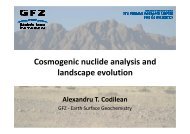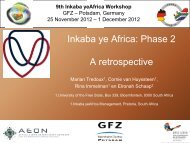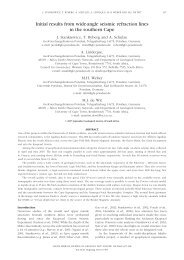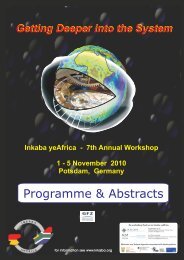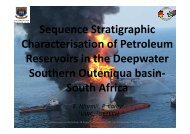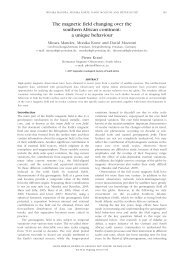South Africa - Inkaba.org
South Africa - Inkaba.org
South Africa - Inkaba.org
Create successful ePaper yourself
Turn your PDF publications into a flip-book with our unique Google optimized e-Paper software.
Environmental changes in Lake Tswaing during the last 84 ka<br />
BP<br />
Frauke Schmidt 1 , Hedi Oberhänsli 2 , Heinz Wilkes 3<br />
1. Helmholtz-Zentrum Potsdam, Deutsches GeoForschungsZentrum GFZ, Germany, fschmidt@gfzpotsdam.de<br />
2. Helmholtz-Zentrum Potsdam, Deutsches GeoForschungsZentrum GFZ, Germany, oberh@gfz-potsdam.de<br />
3. Helmholtz-Zentrum Potsdam, Deutsches GeoForschungsZentrum GFZ, Germany, wilkes@gfz-potsdam.de<br />
ABSTRACT<br />
The lacustrine sediments from Lake Tswaing provide the longest continuous record of palaeoenvironmental change<br />
from the southern <strong>Africa</strong>n subcontinent. The lake formed in an impact crater by the inflow of groundwater and<br />
precipitation and at present, the lake is a highly saline and anoxic environment partly due to enhanced evaporation<br />
during the dry winter months. For a comprehensive understanding of the climatic influence on the evolution of the<br />
lake environment and for insights into the adaption of the lake <strong>org</strong>anisms to the extreme and changing<br />
environmental conditions during the last 84 ka BP, the <strong>org</strong>anic matter in a 35 m long sediment core from Lake<br />
Tswaing was investigated by several geochemical methods.<br />
Lipid biomarkers, i.e., <strong>org</strong>anism-specific chemical compounds, and their stable carbon and hydrogen isotopic<br />
signatures provided information about the dominant <strong>org</strong>anisms and the environmental conditions in Lake Tswaing.<br />
The total <strong>org</strong>anic carbon (TOC) content varied strongly throughout the core ranging from 0.3% up to 9.8% TOC.<br />
Hydrogen isotopic composition of plant-derived n-alkanes indicated that low TOC contents corresponded to dry<br />
climatic conditions which reduced the allochthonous input and the productivity in the lake. In general, algae and<br />
bacteria were the predominating <strong>org</strong>anisms in Lake Tswaing. Both groups showed strong variations and a temporal<br />
succession in response to changing nutrient conditions in the lake during specific intervals; e.g., dinoflagellates<br />
were most prominent in the time before 66 ka BP followed by an period with higher bacterial activity. Alkenoneproducing<br />
algae appeared between 37 and 31 ka BP and showed strong shifts in their abundance which is possibly<br />
related to salinity effects and will be further investigated.<br />
KEYWORDS: Tswaing Crater Lake, palaeoenvironment, <strong>org</strong>anic matter, lipid biomarkers.<br />
73



